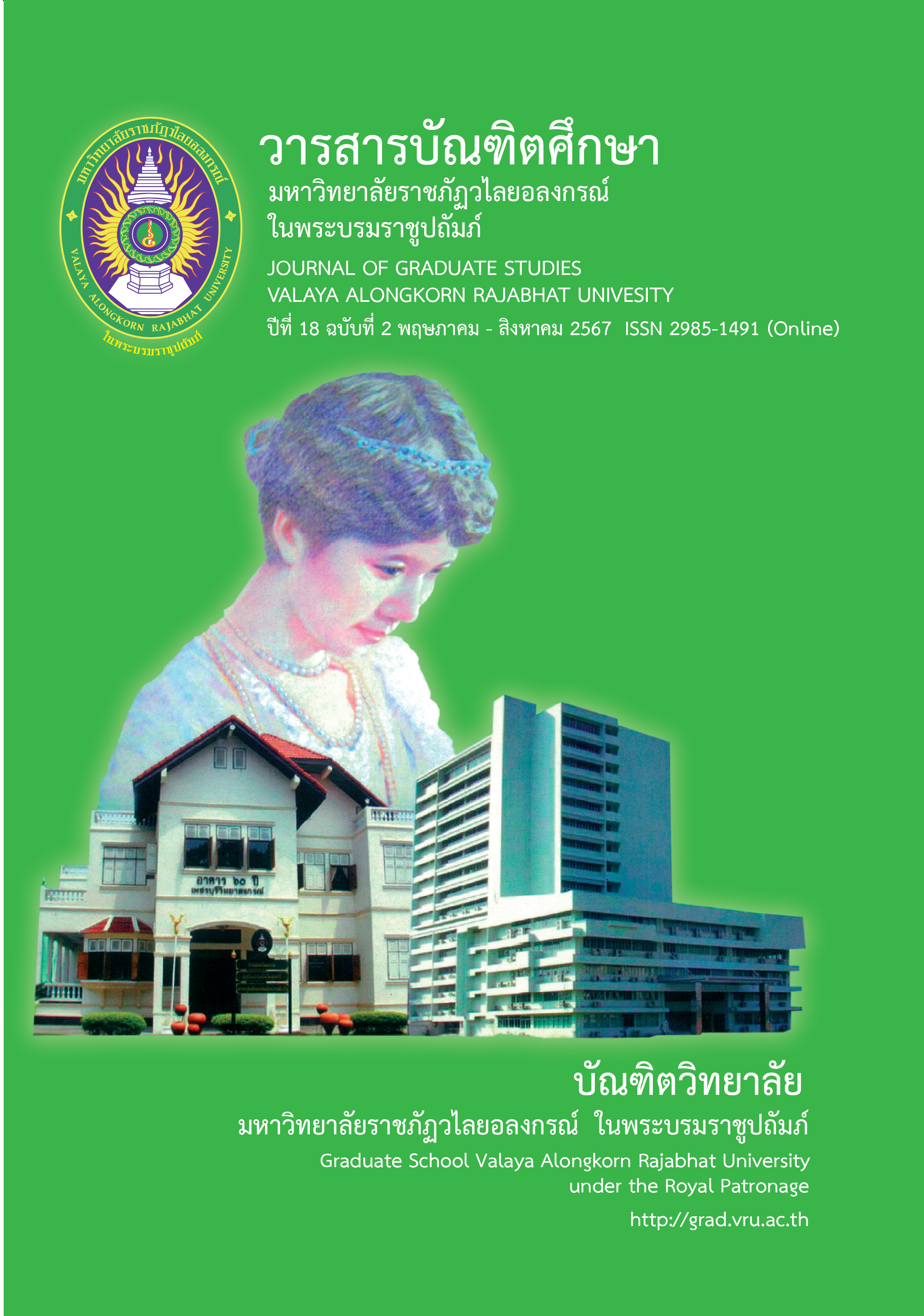THE DEVELOPMENT OF AN 0PEN BASED CREATIVE LEARNING ENVERONMENT MODEL TO PROMOTE THE CREATIVITY OF UNDERGRANDUETION STUDENT.
Main Article Content
Abstract
The objectives of this research were to 1) develop a creative open learning environment model to promote creativity among undergraduate students, 2) compare the academic achievement of students before and after learning using the following formats: Creative Open Learning Environment Model, 3) assess the creativity of students who study with the Creative Open Learning Environment Model to promote the creativity of undergraduate students developed, and 4) study the satisfaction of students who study with a creative open learning environment model as a base to promote the creativity of undergraduate students. Sample group used in research by purposively selecting undergraduate students. Faculty of Fine and Applied Arts Khon Kaen University. There were 30 students in the field of Visual Communication Design. The research tools included learning management plans. Academic achievement test Evaluation form of open learning environment Satisfaction level measure and creativity assessment Statistics used in research include mean, and standard deviation. and t-test statistics
The results of the research found that 1) the creative open learning environment model as a base to promote the creativity of undergraduate students was found to be overall appropriate and in the most suitable criteria ( = 4.63, SD = 0.56). 2) The results of comparing the creativity before and after studying of students who studied with a creative open learning environment model as a base to promote the creativity of undergraduate students. It was found that the average score after studying was higher than before. study, which is significantly different at the .01 level. 3) The results of the evaluation of creativity after the study found that the overall picture was at the highest level (
= 4.54, SD = 0.55). And 4) the results of the student satisfaction study found that the overall picture was at the highest level. (
= 4.53, SD = 0.55) It can be concluded that the developed open learning environment model can promote the creativity of undergraduate students. It also results in students having higher academic achievement.
Article Details

This work is licensed under a Creative Commons Attribution-NonCommercial-NoDerivatives 4.0 International License.
บทความทุกเรื่องได้รับการตรวจความถูกต้องทางวิชาการโดยผู้ทรงคุณวุฒิ ทรรศนะและข้อคิดเห็นในบทความ Journal of Global of Perspectives in Humanities and Social Sciences (J-GPHSS) มิใช่เป็นทรรศนะและความคิดของผู้จัดทำจึงมิใช่ความรับผิดชอบของบัณฑิตวิทยาลัย มหาวิทยาลัยราชภัฏวไลยอลงกรณ์ ในพระบรมราชูปถัมภ์ กองบรรณาธิการไม่สงวนสิทธิ์การคัดลอก แต่ให้อ้างอิงแหล่งที่มา
References
Bangkok University Research Center. (2012). khwāmkhit sāngsan kap kānphatthanā prathēt [Creativity and national development]. Retrieved from https://bangkokpoll.bu.ac.th/poll/result/poll577.php?pollID=436.
Bank of Thailand. (2013). talāt rǣngngān Thai læ botbāt nai kānsāng khwām khængkrǣng hai sētthakit Thai [Thai labor market and its role in strengthening to the Thai economy]. Bangkok Bank of Thailand. 57.
Best, J. (1977). Research in education. New Jersey: Prentice Hall, Inc.1977, 174.
Dade, C. (2010). Edited by, James Bellanca & Ron Brandt. Comparing frameworks for 21st century skills. 21st Century skills: Rethinking how students learn. Bloomington, IN: Solution Tree Press, 51-76.
Faculty of Fine and Applied Arts. (2019). khūmư̄ naksưksā radap parinyā trī [Graduate production]. Khon Kaen University printing.
Lyman, F. (1981). The responsive classroom discussion. In A. S. Anderson (Ed.), Mainstreaming Digest. (pp 109-113) College Park, MD: University of Maryland College of Education.
Mungmai, Y. (2023). kānphatthanā rūpbǣp saphāpwǣtlō̜m thāngkān rīanrū pœ̄t bǣp sāngsan pen thān phư̄a songsœ̄m khwāmkhit sāngsan khō̜ng naksưksā radap parinyā trī [The develop a creative-based open learning environment model to promote the creativity of undergraduate students]. Thesis for Doctor of Philosophy (Education Technology and Communications) Mahasarakham University, May 2023, 135.
Namna, C. (2018). kānsưksā phon samrit thāngkān rīan wannakhadī Thai khō̜ng nak rīan namat yom sưksā pī thī sī thī čhatkān rīanrū dōi chai rūpbǣp kānsō̜n bǣp sāngsan pen thān [A study of learning achievement in literature. of Thai high school Students 4 that manages learning by using a creative teaching style as a base]. Journal of Education Silpakorn University. 16(2), 113–128.
National Statistical Office. (2016). phāwa kān wāngngān wārasān sarup phon thī samkhan kānsamrūat phāwa kān mī ngān tham khō̜ng prachākō̜n 2016 [Unemployment. The journal summarizes important results of the 2016 Employment Situation Survey (2017)], 26-37.
Office of Social Promotion of Learning and Youth Quality. (2015). pœ̄t khū fǣt khwām hē ʻom lam khunnaphāp kānsưksā - sēttha kit” [Open the inequality twin "education quality - economy"]. Retrieved from https://www.komchadluek.net/kom-lifestyle/202042.
Peerapan, N. (2014). kānphatthanā rūpbǣp kānchai theknōlōyī sārasonthēt læ kānsư̄sān phư̄a phatthanā thaksa kānrīanrū nai satawat thī yīsipʻet samrap phū rīan nai radap ʻudomsưksā [The development of a model for using information and communication technology to develop learning skills in the 21st century for learners at the higher education level]. Journal of Education Prince of Songkhla University Pattani Campus. 3(25), 20-33.
Panich, W. (2012). withī sā ngō̜kān rīanrū phư̄a sit nai satawat thī yīsipʻet [Ways of learning to create for students Rule 21]. Retrieved from http://thesis.swu.ac.th/swuebook/h407867.pdf
Ruechaipanich, W. (2014). kānsō̜n bǣp sāngsan pen thān Creativity–based Learning (CBL) [Creativity-based teaching creativity-based learning (CBL)]. Journal of Innovative Learning. 1(2), 1-16.
Ruechaipanich, W. (2015). kānsō̜n bǣp sāngsan pen thān [Creativity-based learning]. Journal Learning Innovation. 1(2), 23-37.
Srisaard, B. (2002). kānwičhai bư̄angton [Preliminary research]. 7th printing. Bangkok: Suweeriyasan Boonsiri, printing, 121.
Saiyot, L. & Saiyot, A. (1995). theknik kānwičhai thāngkān sưksā [Educationalresearch techniques]. 4th printing. Bangkok: Suweeriyasan, 248-249.
Torrance, E. P. (1962). Guiding Creative Talent. Englewood Cliffs: Prentice-Hall.
Tunwatthana, R. (2000). kānphatthanā khwāmkhit sāngsan dūai theknik kān khit nō̜k krō̜p [Creativity development through Out-of-the-box thinking techniques]. Suthiparitad Journal. 18(55), 77-78.


